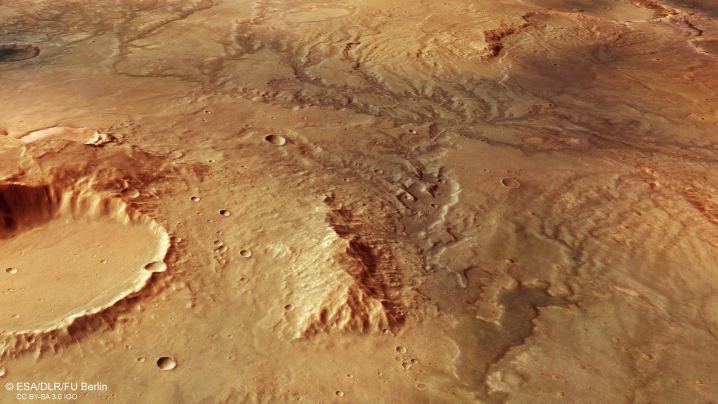
Although it’s now well known that there is frozen water on Mars, scientists are not yet certain whether liquid water exists on the planet. Researchers have discovered what may be liquid water hidden under an ice cap and have speculated the water could theoretically be warmed by underground volcanoes, but the presence of liquid water is far from certain. However, Mars may be cold and dry now, but evidence suggests in the distant past the conditions on the planet were very different.
The European Space Agency (ESA)’s Mars Express orbiter has captured images of a region of branching valleys and trenches which suggest that liquid water once flowed on the surface. The topography of the region in the southern highlands of Mars, near the Huygens impact crater, suggests that water flowed downhill from the north towards the south, creating valleys of up to 1.2 miles (2 km) across and 656 feet (200 m) deep.

Researchers believe that billions of years ago Mars had a thick, dense atmosphere which locked in heat and kept the surface of the planet insulated enough for liquid water to flow. Mars’ atmosphere was gradually lost over the years due to changes in its magnetic field, and the planet’s surface became colder. Additionally, the volcanic activity within the planet may have changed too, reducing the heat generated from beneath the surface, making it so cold that water on the surface would freeze. This is part of the reason that Mars became inhospitable to life.
“Today, it is thought that climate change took place on Mars about 3.7 to 3.8 billion years ago, when environmental conditions changed from a somewhat neutral, potentially life-sustaining and sporadically humid environment to a much more acidic, dry, cold environment that is hostile to life,” Dr. Ralf Jaumann, a researcher in the DLR Institute of Planetary Research and principal investigator of Mars Express’ High Resolution Stereo Camera, explained in a statement.
“This climate change transformed our neighboring planet from being a one with temporary rivers and lakes that was, so to speak, ‘full of hope’ as regards the possible emergence and development of life, into a one that was just dry and salty.”
Editors' Recommendations
- Otherworldly Mars image shows ripples sculpted by dust devils
- Watch the European Space Agency test the parachute for its new Mars rover
- NASA Mars orbiter spots China’s rover on Martian surface
- NASA’s Mars helicopter aiming for new record on next flight
- Mars helicopter Ingenuity passes fourth flight and has a new mission




